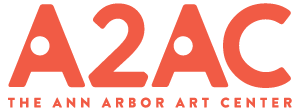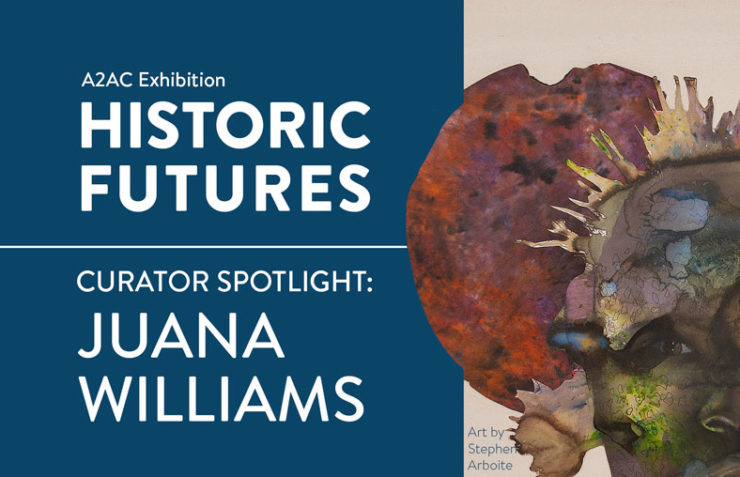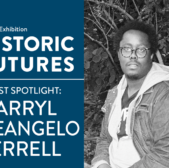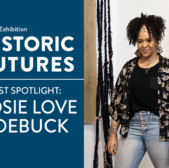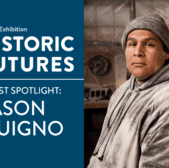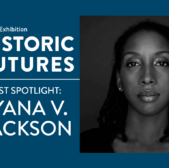This blog features a conversation with Juana Williams, the curator for “Historic Futures,” a multidisciplinary exhibition bringing together artists who explore history, create commentary around current happenings, and dare to imagine a distinctly different future.
This exhibition opened on November 12th at 6 pm, and it served as the first preview of the 2022 exhibition season AND the A2AC’s brand-new street-facing gallery at 115 W. Liberty in the heart of Ann Arbor’s Creative District.
For more information about Juana, the exhibition, and the artists, please visit the A2AC site.
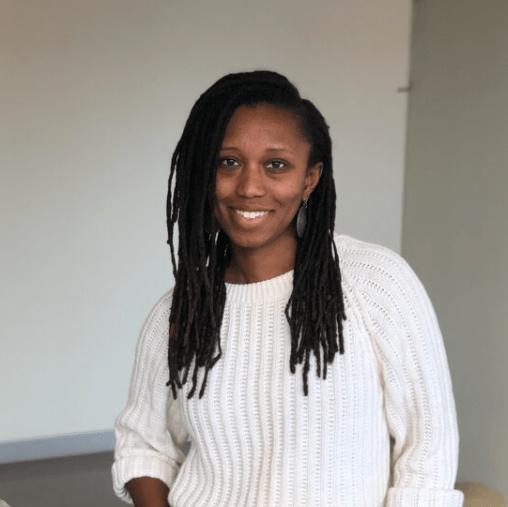
Sonimar Maldonado-Alvarado: Who are you? What do you do? Where are you from?
Juana Williams: My name is Juana. I moved back to Detroit last May in 2020, after working in Grand Rapids for a few years. I’m an Independent Curator, but I am also the Director of Exhibitions at Library Street Collective here in Detroit. So I do a little bit of everything.
Sonimar: How have you gotten to where you are now?
Juana: I learned about curation through my undergraduate program. I got a degree in art, but you had to take art history courses as well. That’s when I found out that I loved researching more than I loved the practice of making art.
I went ahead and graduated because I was close to graduation. Then I went back to school for a Master’s in Art History. While in graduate school, I did some internships; I got a few jobs at different local museums, which was the beginning of my career.
When I graduated, I got a job as a curator in Grand Rapids, taking me away from Detroit. After a while, I moved back to Detroit and worked as an independent curator until I got this job as a Director of Library Street Collective.
Sonimar: What are your passions? What inspires/thrives you? (ie. Personal, Communal, Professional, Artistic)
Juana: I love curating. I love to research and write about art and artists. I love doing studio visits and having conversations with artists. But a big reason I got into this work is more to support communities than to have a career and voice. I want to raise other voices. So frequently, when I get platforms to curate, I use that as an opportunity to give those platforms to artists.
I believe that moments to be creative are significant, but it is also essential to experience different types of art. I’m always advocating for artists and art center spaces to continue working and existing. There’s already not enough government funding that goes to the arts, in a significant way, especially to individual artists. So, I’m always trying to find opportunities to provide to artists.
Sonimar: What are the most memorable moments in your career?
Juana: This is something that kick-started my career. I was working at the Detroit Institute of Arts as a curatorial assistant to a curator there. We were working on this exhibition [Art of Rebellion: Black Art of the Civil Rights Movement] that focused on the 1967 riots in Detroit. They were race riots that occurred honestly across the nation, but we focused on Detroit. It was an opportunity for me to meet and spend time with many older black artists, who I had never experienced before. They were all names that I researched when I was in graduate school. And I was super excited because, you know, I love their work, their career, and the activism they’d done throughout their careers. It was so important to me and having the opportunity to meet them just meant the world.
Also, during that time, I was working directly under a curator of African-American art, which was my focus back then. I think that’s when I understood what curators do. Like many, when thinking about curation, you can believe that it’s just choosing art to put on a wall, and that’s the extent of it. That’s if you’ve even ever heard of the word curator before. Still, it’s so much more complex. There’s so much that happens behind the scenes in terms of curation. Even before you get to the point of choosing the artwork: You need to choose themes, work with development teams, work with the learning and engagement teams, and all kinds of different aspects that compose a curator’s work.
As a curator in a museum, she took me under her wing; she explained all that to me and even let me come to meetings sometimes. Working there was when I got the chance to understand what curators do and how I could impact that career. That’s when I figured out for sure that I wanted to be a curator.
Sonimar: Do you have any fun facts about you that you would like to share?
Juana: I’m very passionate about the environment and nature. I spend a lot of time in nature; I love to camp and things like that. I’m not the type of person who talks a ton about it. I don’t try to guilt or judge people who are not eco-friendly or anything like that. Only in my personal life and within my family, I try to make sustainable choices.
I recognize that we don’t just have a relationship with nature, but we’re a part of it. So we must give back to nature. That’s something we as humans understood in the past, and then we got away from it, especially during the industrial revolution.
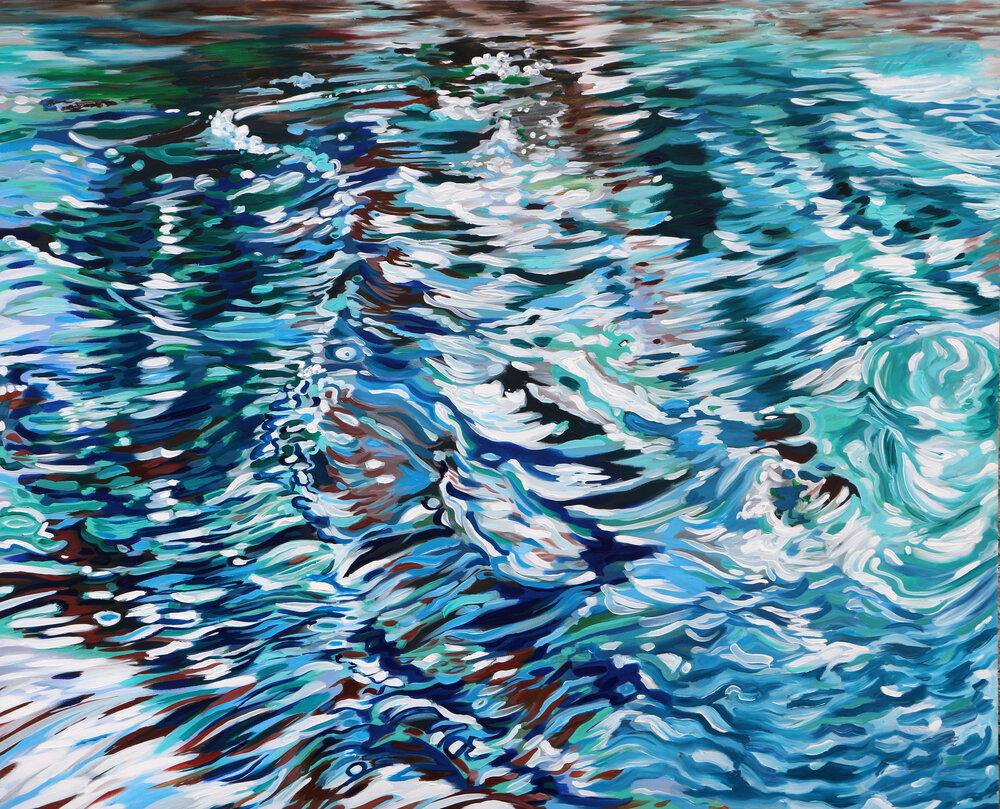
Photo from Breathe. Exhibition Curated by Juana Williams.
I’ve curated a few exhibitions that speak to the point of how we’ve lost that connection, and we’re misunderstanding the ways that we should be interacting with nature. [Breathe and Human|Nature] We’re much more focused on technology and convenience than we are on nature. So yeah, that’s something that I’m passionate about.
Sonimar: What were some of the inspirations that led to the theme for this exhibition?
Juana: I think I started thinking about these ideas before talking to Andrew and before I even knew it would necessarily become anything. Around 2019, I felt like a lot was going on. At least during my adulthood, there hadn’t been as many political times similar to that year. It felt like the country was divided into many different topics, and both sides were very passionate about what they believed in. That just made me take a look at how other people think. Their upbringing, if they grew up in another country, the type of family they came from, their religion, all those things that sort of guide who we become as adults and how we choose to live our lives throughout adulthood.
I was thinking about that, then thinking about the pandemic, and like how life felt crazy. The last couple of years, life has just felt sort of crazy to me. I think more than any other year of my adulthood, and that got me thinking about time capsules in a sense. What would be significant enough to go into it if we created a time capsule in 2019 or 2020? And then I thought: “I will have a specific idea of what will go into it, but others might have a different opinion, and it might be completely the opposite as mine.”
Then you have to factor in what people’s experiences are. I always tell people with curation that if you can come into an exhibition as open-minded as possible, you’ll have a much better experience. On the other hand, I let the artists know that just as they bring what they can into their artwork based on their own life, the audience will also bring their own experiences into pieces, and their understanding of the work might be completely different.
I was thinking about those two concepts, the time capsule and how we view and experience artwork, instead of how it’s created and artists’ intention. I called it Historic Futures because I wanted to think about what’s happening now that will be important in the future. Whether that means in a physical sense, like creating this time capsule, or in a cultural and social-political way, like what’s happening now, that might shift our country’s trajectory or our world. For example, I think of how different countries deal with the pandemic and how it’s making significant changes. Leaders are creating laws, cultures are changing, and that’s happened throughout time.
I wrote in the exhibition description that when you think about the future, you have to also think about the past. You have to think about where we came from and what’s already happened because you don’t want to repeat the negative aspects, and you want to learn from them and find ways to move forward and figure out the information we should take with us into the future.
When I talked to Andrew, we spoke about this idea of flexibility and the importance of understanding that we’re a global society. That we can’t think everyone should practice the same religion or have the same political opinions. Most topics are very complicated and very subjective. So this exhibition is like an encouragement to be open-minded and try to understand people who are different from you.
Overall, I hope that people come into the exhibition with an open mind and take in the art as best as possible.
Sonimar: How did you choose the artists?
Juana: I choose artists who I think have great work. Especially when you have a shorter deadline, it is always beneficial to work with artists you’ve worked with before. So some of them I know personally, and some it’s the first time working with them. Of course, that wasn’t the only criteria; their work needed to fit into the exhibition’s theme.
When I first started planning the exhibit, I wrote out the text and figured out the theme, and then I started thinking about specific topics. While considering our history and the future, I think it’s easiest to have a bullet point list of issues you want to address. The process was similar to having a conversation with a friend and asking, “what do you think the future would look like? Or what is happening right now that you think will be important in the future?”
So then, I started thinking of a variety of topics that are essential for the future. Among them were: immigration, parenthood or children, LGBT rights, and their relationships in terms of our cultures, the environment, and Native Americans in our history. Once I had my general list, I started thinking, “do I know any artists, even if I haven’t worked with them before or don’t know them personally, do I see any work that fits into that theme?”
That was how I decided which artists should be included. After that, it came down to getting in contact with them and finding out if they had work available during that time or not.
Sonimar: Could you talk briefly about some of the works that will be in the show?
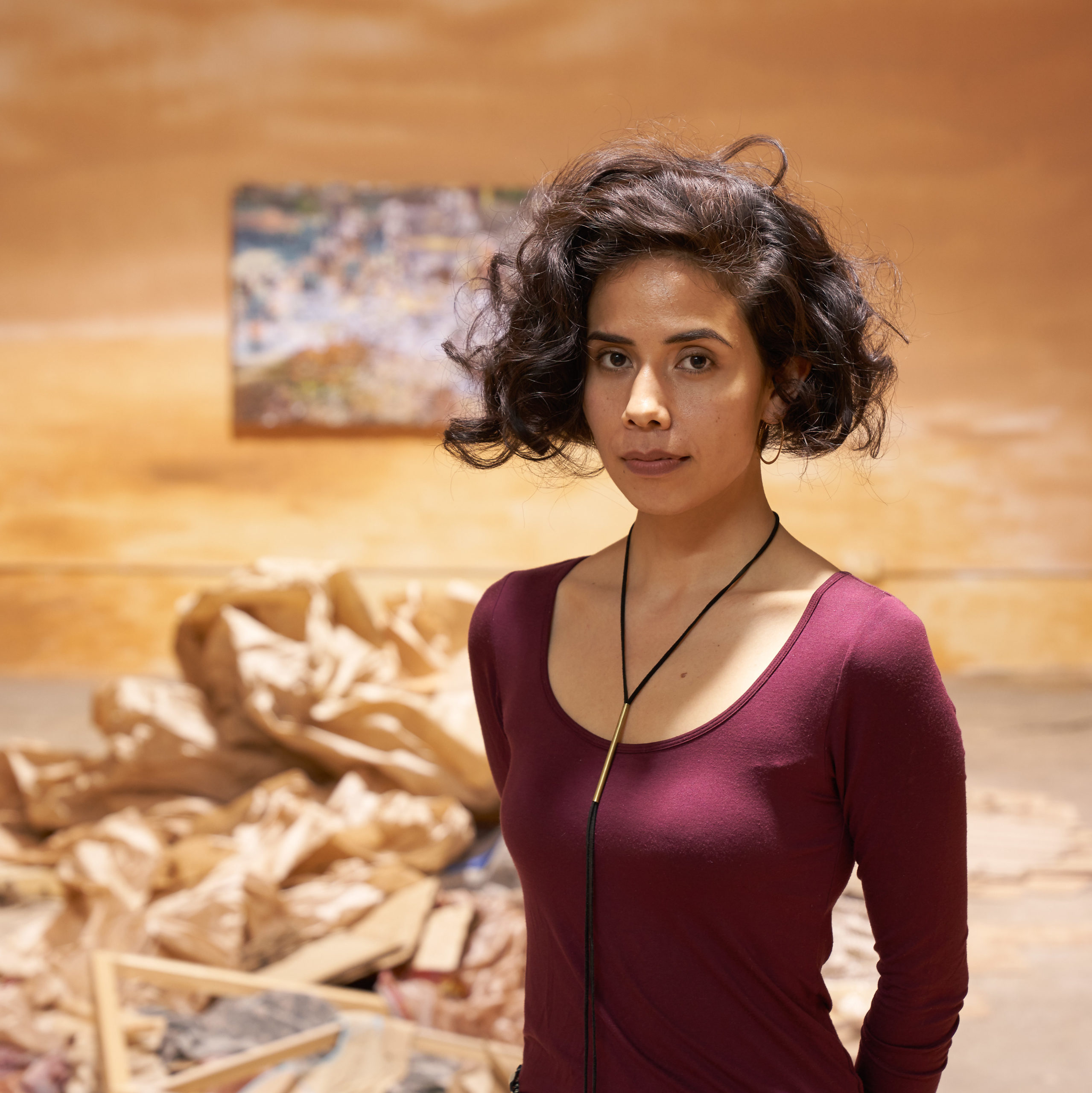
Juana: Yes. I know Camille is doing a piece about immigration. She’s based in New York, but she will come and install her work right before the show opens. I found her work online, and this will be the first exhibition where we work together. She does cutouts made out of wallpaper, and the way she cuts them out is similar to how we draw a figure, so it’s like a human body. Interestingly, her work is the final visual product and the work that she does beforehand. She researches where the work will be installed and creates work based on that location.
She and I were having conversations, and she also did independent research about Michigan and the vast logging industry, different laws in place here, and immigration. Like how one of Detroit’s suburbs has a substantial Arab community, we have community areas with many Puerto Rican and Mexican people who have immigrated here in Detroit. Also, I know that in West Michigan, there’s a sizable Dutch population that immigrated a long time ago.
These were some of the topics we touched on. With some extra focus on immigration because it is a complicated issue, especially with the last few presidents. It’s been more visible in the media. Because of that, the general population is paying more attention to what’s happening in terms of immigration. So that was something I wanted to make sure I included.
Let me see who else? There’s another artist who talks about immigration but differently, and his name is Stephen. His family is originally from Haiti, but I think he was born here in New York. He’s a first-generation American, and he talks about immigration from the perspective of his family being immigrants and what that means in terms of him. What it’s like being home and learning about Haitian culture, and then being out in New York City learning about the US culture, and the sort of dichotomy between the two. But he takes a much more spiritual or existential approach to the topic.
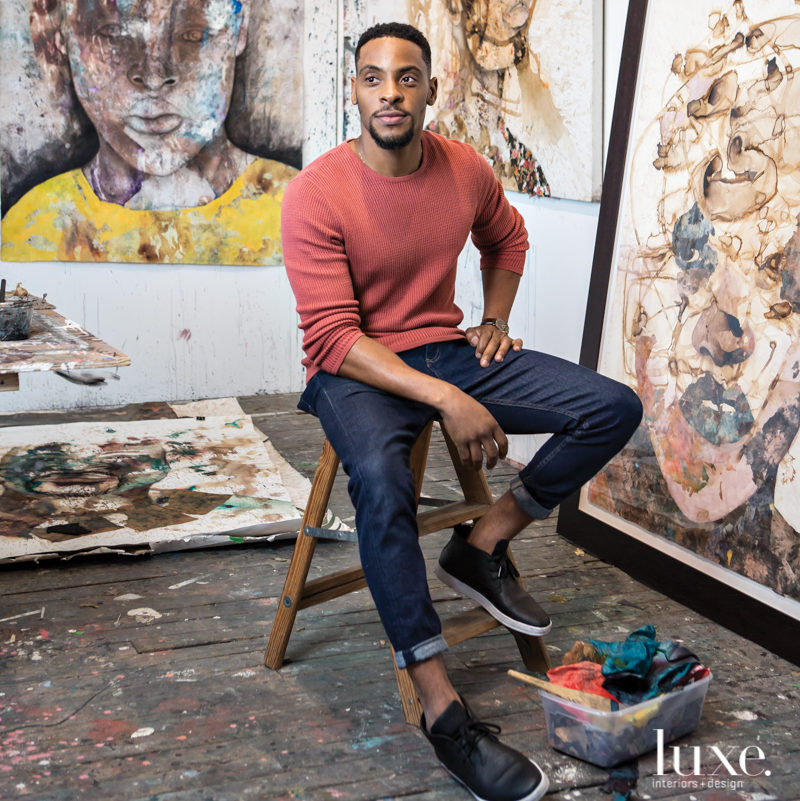
While Camille’s work is very much particular to the exhibition’s location, things that happened there, and much more research-heavy, Stephen is much more about what he is feeling in the moment of creating work. You can see the differences in their work. It’s undeniable that they have very different visual styles.
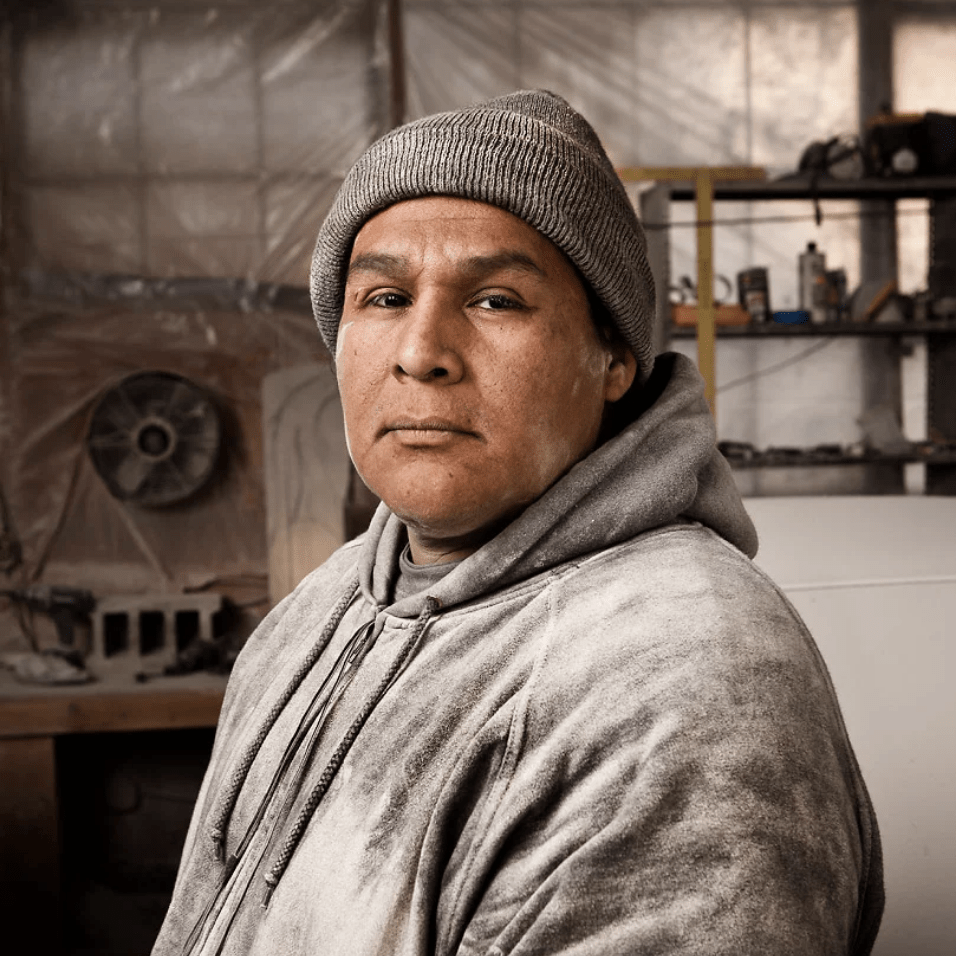
I will talk about Jason next. Jason is a Native American artist, and he received training in carving stone in the Anishinaabe traditional way. Nowadays, he’s taking his practice a step further by teaching other people. For this exhibition, Jason will be making a new sculpture that I haven’t seen before. But since I have worked with him previously and have seen a lot of his work, I trust him to do whatever he wants because I know it will be excellent.
His work is very much rooted in his culture as an Anishinaabe artist. He grew up on reservations, and after everything changed, he now tries to understand the Native Americans’ place in this new American society. So much of his work has to do with animals and our relationship to nature while including his identity as a native American.
I’ll talk about one more. Lisa Alberts is a Michigan artist; her work focuses on the subject of motherhood. I knew I wanted to include children because there will be a point where we’re not here anymore, and this will be their world. So I felt that if you’re talking about the future, you have to include children; it really wouldn’t make sense not to.
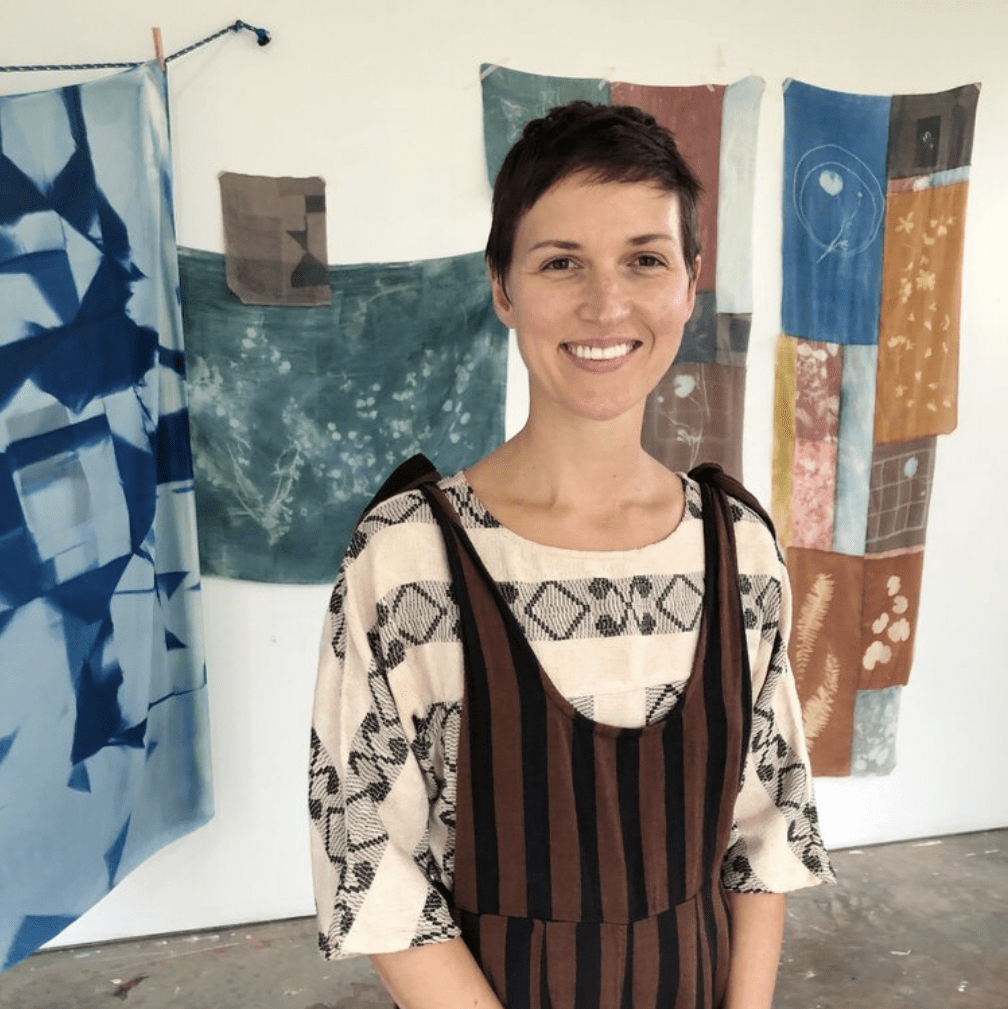
I know a lot of artists who are parents, but what’s interesting about Lisa’s work is that she includes her children in the art-making process. I believe including them within the work started during the pandemic because her children were always there. They couldn’t go to school, and the world sort of looked a lot different. So she brought her children into her studio and allowed them to participate in the practice of doing her work. So I feel like that’s as close as you can get to discussing children and involving children in the exhibition.
Also, Lisa is a fiber-based artist, which I sort of have a special place in my heart for fiber-based artists. I love fiber work, but mostly because it doesn’t get the recognition it deserves. In most of my exhibitions, I usually try to include at least one fiber-based artist. This exhibition, I think, has two.
Sonimar: What kind of response (if any) do you hope to receive from the audience?
Juana: I try to make my practice community-based as much as I can. When I’m thinking about curation, I think a lot about the audience involved in it. Not just this blanket term audience, meaning whoever comes in, but the audience who is physically near that place. I think about what will be attractive to them or what conversations need to be happening in this place.
It is an integral part of my practice to allow the audience to share these ideas and hope that people walk away with something to say about it to their friends and family. I hope it leads to conversations, especially for an exhibition like this, where the artwork is not necessarily controversial but presents different subjects of relevant interest.
Also, I never hope that people enjoy the work. I hope that they react, whether that means they love it or hate it or whatever. I hope that they feel something and don’t just walk through and have no reaction. I feel like I didn’t do my job if most of the audience comes to the exhibition and doesn’t take anything away. That’s the biggest thing for me.
Sonimar: Besides working on Historic Futures, what other projects have you been (or will be) a part of?
Juana: Well, I work full time at Library Street Collective, so that’s taking up most of my time. I also do a lot of independent research. I hope to have more time to do that soon!
I’ve been thinking a lot about our relationship to the environment, but also thinking about environmental justice; and have been doing a lot of research about how specific people in certain types of communities around the world, and this country, have to deal with the ramifications of the climate crisis more than others.
It is not about how much these communities are affecting the current climate crisis. Usually, it’s wealthier countries and wealthier people who are causing the issues, but then the not-so-rich countries and people are the ones who deal with the repercussions.
I have been looking into sanitation locations and why our country has chosen to put them in specific neighborhoods instead of others. Also, where natural disasters happen and why it impacts certain people more significantly than others.
I am also trying to understand why black and brown people have to deal with the climate crisis and the issues that come from it, a lot more than white people do, and how that was very much planned. It was an intentional decision in our country’s past, and that is a specific indication of many systems in place here.
So I don’t know; that’s my research that I’m honestly just doing because I’m interested in it. I hope to write about it soon and maybe get published in some scholarly articles and things like that. But in terms of curation, I don’t have anything else coming. Most of my time is spent here at Library Street.
Sonimar: Could you expand on your perspective on social-political issues that may have inspired your career or this exhibition?
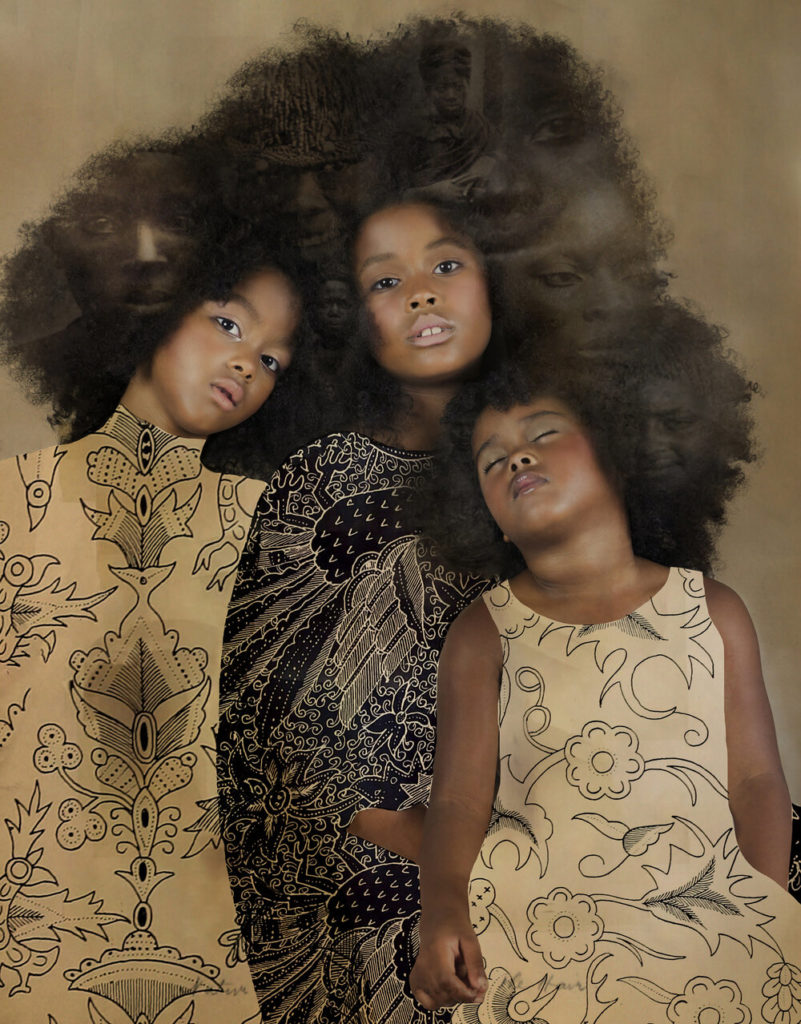
Juana: I think that just existing in this body makes me have to pay attention to those topics. I don’t have the privilege of ignoring it because I’m so affected by it, and many of the people I’m closest to are so affected by social-political issues. When I was in graduate school like I said, my focus was African-American art; I wrote my thesis on black female artists and just understanding intersectionality and the double burden that we have to deal with in terms of being black and female in the US, although I love being a black woman.
That’s not necessarily my focus now. I’ve expanded it, but I think I got into this career already thinking about social, cultural, and political issues with that as my foundation. Like I can’t― I can’t turn away from it; it’s involved in every exhibition in some way, even if it feels like it’s not. Because in the same way, I said that an audience brings their experiences to a show, I bring my experiences to curation. I can’t pretend like it didn’t happen, or I can’t act like my identity is not what it is. That would be negating my experiences, which I believe are valuable.
It has had a massive impact on my career, and it’s inspiring the way that I curate and the topics that I focus on in terms of curation. Because I get to choose as the curator what information should be out in the world, that’s very much based on what’s important to me or what I think might be significant to other people in that area.
Sonimar: Great! That is all the questions for this interview. Thank you so much for giving us your time and expertise to make what I believe will be an excellent exhibition. I will be seeing you at the Opening Reception on Friday, November 12th at 6 pm!
Juana: Thank you. See you there!
Be sure to join our mailing list and follow us on Facebook, Instagram, and Twitter to learn about upcoming events, classes, and exhibitions!
